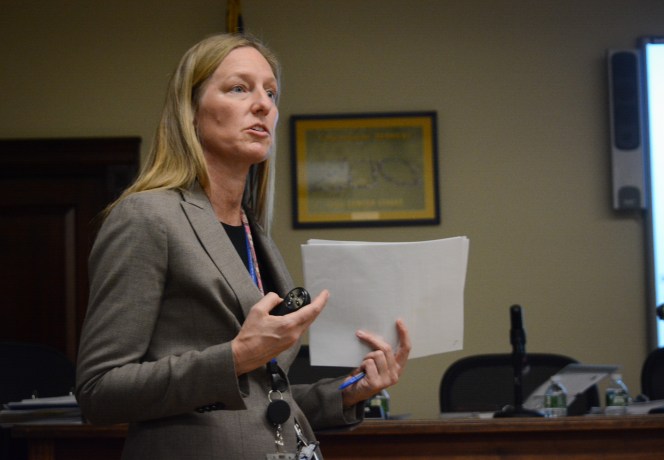Herricks school officials focused on the expenses of its $114.16 million budget proposal at a presentation on Thursday night, noting the need to deal with cost drivers out of their control while retaining their programming.
The $114.16 million budget would be a $2.94 million, or 2.65 percent, boost from the current budget. This comes with a 2.55 percent increase to the tax levy, from $94.09 million to $96.49 million – or $2.39 million.
This year’s tax cap is higher than usual, according to the school district, with the tax levy increase averaging 1.44 percent over three years, including this year.
Just over three-quarters of the budget goes towards school programming, which is worth $86.78 million. This includes teacher salaries, materials, and supplies.
Lisa Rutkoske, the assistant superintendent for business, said that many budget items were out of the school’s control.
The teacher retirement system, which is run by the state, calls for a 10.63 percent increase from the current 9.8 percent. This is somewhat offset by the employee retirement system, also run by the state, which calls for a decrease from 15.3 percent to 14.9 percent.
The school district also anticipates a 10 percent year-on-year increase in employee healthcare insurance costs, Rutkoske said, although this is “mitigated” by increased employee contribution rates.
“It really is systematic, I think, across the United States right now,” Rutkoske said.
According to the presentation, employee benefits will go up 7.47 percent – or from $25.26 million to $27.15 million. This translates to more than half the overall expenditure increase for the school district.
Instruction costs, meanwhile, would rise 0.84 percent – or by $549,499 – from $65.71 million to $66.26 million.
Additionally, though, the school district does not anticipate to see more than a “nominal increase” in state aid, which makes up 10 percent of the budget, Rutkoske said.
According to the presentation, Herricks schools is slated to get a 2 percent increase in total state aid and a 0.25 percent increase for foundation aid – or $17,134 – although this could change.
But, Rutkoske said, New York is not following the foundation aid formula it created in 2007, meaning Herricks is actually seeing $4.72 million less than it should.
Capital projects, which focus on facility improvements, make up 13.65 percent. Administrative costs, meanwhile, would be worth $11.79 million – 10.34 percent of the budget.
The proposed budget also includes funding for two new school buses, as many of the buses are over 12 years old and have 100,000 miles on them, Rutkoske said. This makes up most of the $272,414 increase in transportation costs from $3.43 million to $3.7 million.
The proposal also features funding for the expansion of STEM programs, expanded Nassau BOCES health and safety services, new fire alarm smoke heads, broken sidewalk replacements and new equipment like tablets, smart boards, and Chromebook carts.
The next budget discussions will take place on March 22, April 12 and May 3. The budget adopted by the school board will then be subject to voter approval on May 15.
In unrelated business, trustees announced that the state education department approved phase 2 capital projects for the school, which will include cafeteria renovations.
“It’ll be an exciting summer for Herricks,” Fino Celano, the superintendent of Herricks schools, said.
In other unrelated meeting business, two problem-oriented police officers visited the school, outlining what they do to help keep schools safe.
Some of these actions included conducting lock down drills, safety planning with officials, utilizing crime analysts at each precinct, having a presence on social media and investigating every tip extensively.
“Safeguarding children is one of the main things we do as POP,” Todd Atkin, one of the officers at the meeting, said.
The meeting was the first since a mass shooting at Marjory Stoneman Douglas High School in Parkland, Florida, where 17 people were killed. This in turn prompted many schools to closely review their safety procedures and host public safety meetings.
Some students are also hosting walkouts to push for gun reform legislation and remember the 17 victims.

